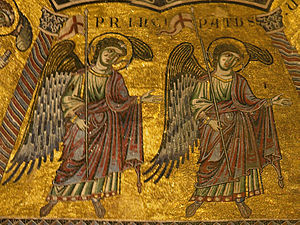In the previous post we looked at the arguments that “the rulers of this age” were human authorities or a combination of spiritual and human authorities as set out by Robert Ewusie Moses (REM) from his Duke University Doctor of Theology thesis of 2012, Powerful Practices: Paul’s Principalities and Powers Revisited. We now begin the case for the earliest known interpretation (Ignatius, Marcion, Justin) that the rulers of this age were spiritual or angelic beings.
Where to begin? REM notes that the literature on this view is “immense” so I start by putting REM’s thesis aside and consulting some of that literature. We have spoken of the older scholarship overwhelmingly viewing the “rulers of this age” as spirit powers so let’s look at some of that seriously older scholarship.
Otto Everling, 1888
Everling, Otto. 1888. Die paulinische Angelologie und Dämonologie: Ein biblisch-theologischer Versuch. Vandenhoeck und Ruprecht. http://archive.org/details/diepaulinischea01evergoog. pp. 11-25
The rulers of this age
- have wisdom but not the wisdom of God
- are currently (present tense) in the process of losing their power
- crucified the Lord of Glory
No class of humans meet all three characteristics. Furthermore, it stretches credulity to think that Paul or anyone would have extrapolated from the actions of Caiaphas, Annas and Pilate that all the rulers of the earth, this cosmos or age, were responsible for the crucifixion of Jesus, let alone that anyone would have understood Pilate to have been a representative of “the wisdom of this age”.
That Paul had angelic powers in mind is supported by contemporary literature that do speak of angels has having a certain wisdom but a wisdom that is limited as well as power over this world
Paul wrote elsewhere of angels being currently in the process of losing their power and that that loss of power will be complete after Christ has finished his reign: 1 Cor. 15:24.
Satan himself is said to be a ruler of this world: John 12:31, 14:30, 16:11, Eph 2:2, cf 2 Cor 4:4, and the ruler of this time of iniquity: Barnabas 18:2. Satan’s knowledge was known to be incomplete as we read in Ignatius’s letter to the Ephesians 19:1.
In Paul’s mind this world is populated not only with humans but with angelic powers. He speaks of himself as one of those doomed to die in the arena of the “cosmos” or world as a spectacle to both people and angels in 1 Cor 4:9. In Paul’s world, angels were active and were destined to be judged by human followers of Christ, 1 Cor 6:3. Satan himself worked on God’s behalf to destroy the flesh of sinners: 1 Cor 5:5. This last passage reminds us of the Destroying Angel working on God’s behalf in the Old Testament. Another reminder of that Destroying Angel is the fate of Ananias and Sapphira in Acts 5:5-10.
Paul also spoke of a servant of Satan attacking his flesh: 2 Cor 12:7.
Paul and his contemporaries understood that their struggles were against heavenly powers, wicked spirits and that these beings had power over flesh and blood. But good spirits were also there to serve the righteous: e.g. Heb 1:14.
Otto Everling’s discussion of this hidden world of angels is far more extensive than I can outline here. Hopefully I have at least hit on some of his main points. Continue reading “What they used to say about Paul’s “rulers of this age” who crucified the “lord of glory””





